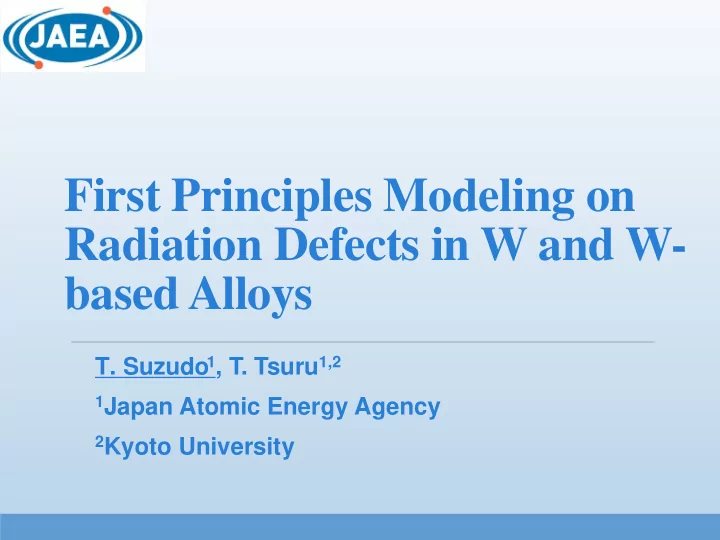

First Principles Modeling on Radiation Defects in W and W- based Alloys 1 , T. Tsuru 1,2 T. Suzudo 1 Japan Atomic Energy Agency 2 Kyoto University
Application of tungsten to nuclear fusion reactor High melting point High resistance to spattering Low hydrogen absorption Blanket Diverter Block Cooling Armoring of plasma facing materials June 18-20, 2019, MoD-PMI 2019, Toki
Irradiation to fusion materials is severe High-energy particle Molecular dynamics by Operational condition of materials in various LAMMPS (BCC Fe) nuclear devices (IAEA GC51) June 18-20, 2019, MoD-PMI 2019, Toki
Neutron irradiation to W causes Re (and Os) through nuclear transmutation Nuclear reaction of W under neutron irradiation Pure W W-6Re-3Os (end-of-service) Cottrrel et al., Fusion Sci. Technol. 50(2006) 89. June 18-20, 2019, MoD-PMI 2019, Toki
Re causes radiation-induced precipitation in W Neutron-irradiated W-5Re 1.54dpa, W-Re phase diagram [1] 750 ℃ [2] BCC Re in W (%) Plate-like or needle-like precipitates ( χ -phase, Re 3 W) Solubility limit of Re > 20% [1] Williams et al., Metallurgical Trans. A , 14A 655-666(1983) [2] Tanno et al., Mater. Trans. 49[10], 2259-2264(2008) June 18-20, 2019, MoD-PMI 2019, Toki
Re in W reduce radiation- induced void swelling Neutron irradiation Neutron irradiation 9.5 dpa, @EBR-II [1] 1.54dpa, 750 ℃ @JOYO [2] W W-25Re [1] J. Matolich et al, Scr. Metall. 8 (1974) 837-841. [2] T. Tanno et al., Mater. Trans. 49 (2008) 2259-2264. June 18-20, 2019, MoD-PMI 2019, Toki
Goal of this study is : To explain the experimentally-discovered Re-effects using the first-principles calculations June 18-20, 2019, MoD-PMI 2019, Toki
Modeling methodology VASP ( Vienna ab initio Used super cell Simulation Package ) Projected augmented wave potential (PAW/PBE) 5a 0 × 5a 0 × 5a 0 (250 lattice sites) super cell K-point (3 × 3 × 3) Cutoff energy: 350eV Nudged elastic band method to calculate migration barrier June 18-20, 2019, MoD-PMI 2019, Toki
Displaced W forms W-Re dumbbell, which migrate and rotate E b =0.8 eV E m =0.12 eV → → + W-Re dumbbell can rotate easily E r =0.03 eV <111> <110> <111> → T. Suzudo, M. Yamaguchi, A. Hasegawa, Modeling Simulation Mater. Sci. Eng. 22 (2014) 075006. 9 June 18-20, 2019, MoD-PMI 2019, Toki
KMC simulation (PAKSS) of 1D SIA and 3D W-Re dumbbell SIA (1D) Production bias W-Re (3D) SIA vacancy Mixed Our results suggest: dumbbell SIA (1D migration) → Accumulation of vacancies Mixed (3D migration) → Enhanced recombination to vacancy → Suppression of radiation swelling T. Suzudo, A. Hasegawa, Scientific Reports vol. 6, 36738 (2016). June 18-20, 2019, MoD-PMI 2019, Toki
Enhanced recombination also explains the precipitation. Binding energy Vacancy SIA (eV) Re atoms are dragged by vacancy and SIA (eV) and aggregated through recombination. Re 0.22 0.79 SIA ‘n’ irradiation Vacancy and SIA bind Re Vacancy β decay Re Our recombination scenario explains both radiation-induced precipitation and suppression of swelling. June 18-20, 2019, MoD-PMI 2019, Toki
Binding energy for other solute atoms are calculated Binding energy of solute elements and SIA/vacancy June 18-20, 2019, MoD-PMI 2019, Toki
Ti, V, and Cr form mixed-dumbbells, but not solute-vacancy complex Binding energy of solute elements and SIA/vacancy SIA Vacancy Recombination does not cause aggregation June 18-20, 2019, MoD-PMI 2019, Toki
W-Ti, W-V, W-Cr dumbbells also Have 3D motion <11h> dumbbell is the most favorable Migration energy of The rotation is easy. mixed dumbbell <111> <111> E m <11h> <11h> <110> <110> <111> <110> E m =0.15 eV for Ti =0.13 eV for V =0.12 eV for Cr T. Suzudo, T. Tsuru, A. Hasegawa, J. Nucl. Mater. 505 (2018) 15-21 June 18-20, 2019, MoD-PMI 2019, Toki
Summary DFT study predicts 3D migration of W-Re mixed dumbbell, this seems a cause of swelling suppression and radiation-induced precipitation. Ti, V, Cr may suppress radiation effect without causing precipitate, but experimental verification is required. June 18-20, 2019, MoD-PMI 2019, Toki
Recommend
More recommend